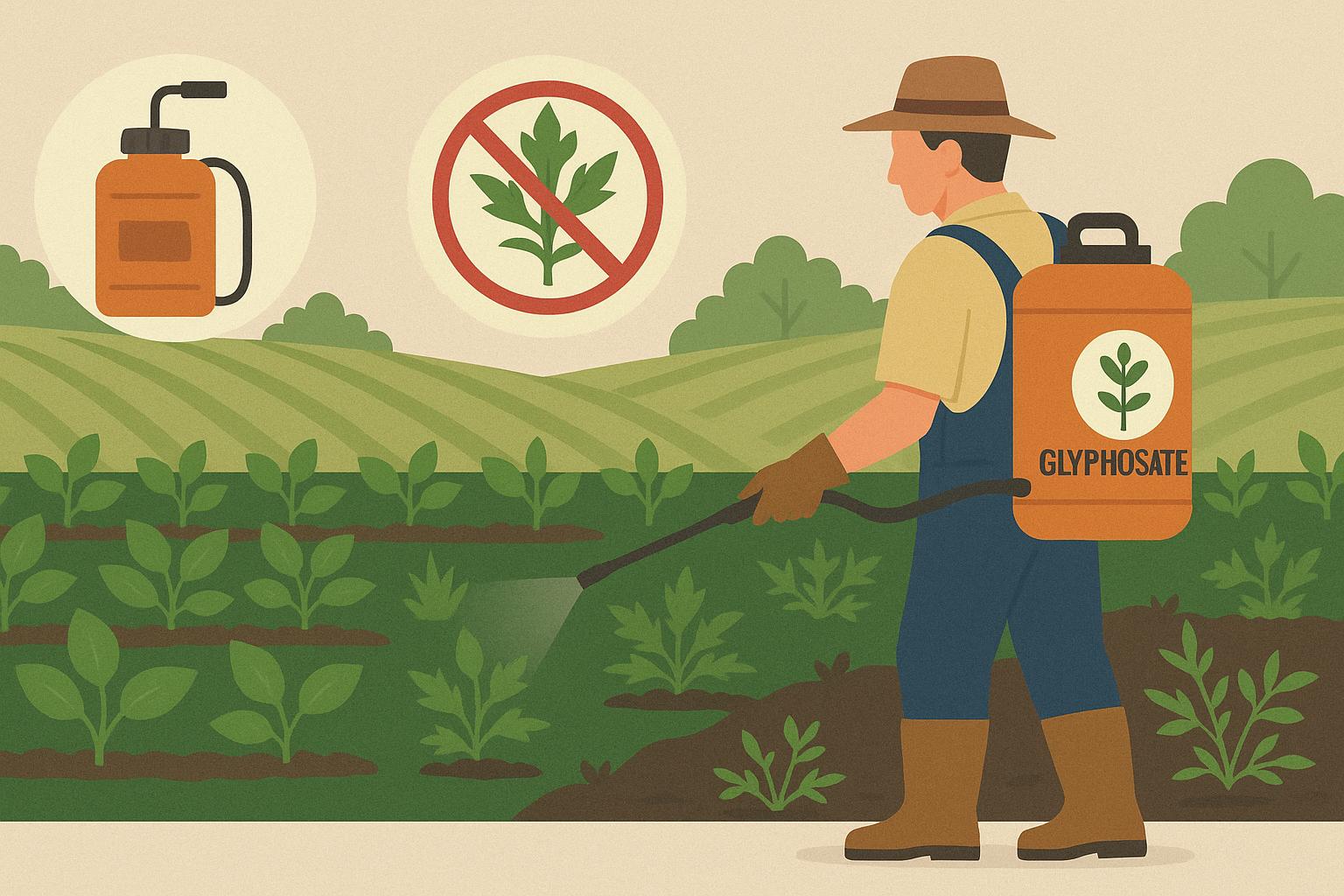10 Field-Tested Glyphosate Hacks for Smarter Weed Management

Weed management is one of the most critical aspects of productive agriculture, and glyphosate remains one of the most potent allies in this fight. Used across millions of hectares globally, glyphosate-based herbicides, including the widely applied Glyphosate 71% SG herbicide, have revolutionized how farmers approach invasive vegetation. However, simply applying glyphosate isn’t enough to get the most out of it. Efficiency, precision, and timing are more crucial than ever, particularly with growing concerns over herbicide resistance and environmental impact.
This guide reveals 10 practical, field-tested glyphosate hacks that go beyond basic spraying, designed for farmers, landowners, and agronomists who want smarter, more sustainable weed control outcomes.
Timing Is Everything: Know Your Window
The first and most impactful hack is understanding when to apply glyphosate. Most weed species are vulnerable during the early stages of growth, especially the 2–4 leaf stage. Applying at this point ensures systemic uptake is fast and lethal. Waiting too long could mean the weeds develop tougher cell walls, reducing glyphosate absorption and efficacy.
In no-till and reduced-till systems, pre-planting applications are highly effective because weeds haven’t had a chance to interfere with the crop. Glyphosate should also be applied under favorable weather—ideally when temperatures are between 15°C and 30°C, and weeds are actively growing.
Mix Matters: Optimize Your Tank Strategy
Tank mixing glyphosate with compatible adjuvants or herbicides can extend its reach and improve uptake. Non-ionic surfactants, for instance, help reduce surface tension on weed leaves, allowing better penetration. Additionally, mixing with herbicides that have different modes of action can prevent resistance buildup.
For optimal results, always refer to compatibility charts and label guidelines. Keep water pH in check too—glyphosate can lose its effectiveness in hard water due to binding with calcium and magnesium ions. Acidifying agents can be used to maintain pH levels in the 4.5–5.5 range, the optimal range for glyphosate solubility.
Target the Right Weeds, Not Just Any Green
One of the most common mistakes in glyphosate application is failing to match the weed species with the herbicide’s strengths. Glyphosate is effective against most broadleaf and grass species; however, knowing your target is crucial. For perennial weeds like Johnson grass or Bermuda grass, higher rates and split applications may be necessary. Timing again plays a role—spraying before flowering for perennial species limits root storage of energy and improves kill rates.
This precision-focused approach is one reason many growers choose to buy Glyphosate 71% SG herbicide products, as the formulation enables accurate dosing, systemic control, and versatility across various weed spectra.
- Use scouting apps or manual records to identify dominant weed species.
- Adjust application rate based on weed maturity, density, and resistance history.
Calibration: The Overlooked Superpower
Although it may not sound thrilling, sprayer calibration is essential. While under-application leads to poor control and the development of resistance, over-application costs money and puts crops at danger of damage. Every spraying season should begin with calibration, as should any time the nozzle, pressure, or speed is altered.
To ensure your sprayer is producing the desired volume per hectare, field experts recommend using a calibrated flow meter or conducting a catch container test. This guarantees that you’re just utilizing the recommended dosage of glyphosate.
Use Shielded Sprayers in Sensitive Areas
When operating near non-target plants, such as edible crops or ornamentals, shielded sprayers help prevent drift. This technique is especially helpful in mixed-crop fields or urban-adjacent farms where unintentional exposure could lead to costly losses or community concerns.
Additionally, avoid spraying during windy conditions with speeds above 10 km/h and select low-drift nozzles when precision is required. Glyphosate is non-volatile, but even low drift can create problems in the wrong context.
“Success in farming isn’t just about working hard — it’s about knowing when and how to apply your tools.”
Know the Rainfast Period
If rain falls before glyphosate is absorbed, its effectiveness is greatly diminished. Although weed type, temperature, and humidity can all impact absorption, most glyphosate 71% SG herbicide formulations are rainfast in 4–6 hours.
When scheduling your spraying, consider both the current weather and the short-term forecast. Because this dilutes the spray solution and prevents absorption, do not spray when the leaves have a lot of dew on them or when the humidity is high.
Embrace Site-Specific Weed Management
Precision agriculture has enabled site-specific weed management, which uses satellite data, drone imagery, and GPS-guided equipment to target areas of high weed pressure. Instead of using blanket spraying, which reduces pesticide consumption while increasing impact, these techniques allow for customized glyphosate use.
Farmers adopting precision tools have reported a reduction of up to 30% in herbicide usage without sacrificing control. For a deeper dive into variable rate technology and precision spraying tools, AgFunderNews frequently explores how digital agriculture is transforming herbicide application.
Use Glyphosate in a Rotation Program
One of the biggest challenges to glyphosate’s long-term viability is weed resistance. Over 40 weed species have shown varying degrees of glyphosate resistance worldwide. To lessen this, rotate herbicides with different mechanisms of action throughout the year. Glyphosate works by inhibiting the EPSPS enzyme, however this is not the only way it works.
Rotating with pre-emergents, implementing cultural practices such as cover crops, and occasionally using mechanical weeding help ensure glyphosate remains effective from season to season. Integrated Weed Management (IWM) isn’t just a buzzword—it’s a necessity for modern farming. Learn more about resistance strategies at WeedSmart Australia, which offers tools and real-world examples.
Apply During the Right Part of the Day
Like all other living things, weeds have a circadian rhythm. Because plants are actively photosynthesizing and metabolizing at this time, studies indicate that glyphosate works best when applied between 9 AM and 4 PM. When plant activity slows down in the late evening or early morning, avoid spraying.
Additionally, during the day, weed leaves are more likely to be open and upright, which enhances glyphosate absorption and coverage. In the field, these minor adjustments can significantly increase kill rates.
Don’t Ignore Post-Treatment Scouting
After spraying, observe how the weeds respond rather than just moving on to the next task. After a successful glyphosate treatment, symptoms such as wilting and yellowing should appear 7–10 days later. Examine survivors to see whether they are showing signs of resistance, were missed, or received insufficient dosage.
Post-treatment scouting helps you improve future application methods by identifying trends that may require you to adjust your approach. This proactive feedback loop is essential for more intelligent weed control.
FAQs
- How soon can I plant after applying glyphosate?
Typically, you can plant 3–7 days after application depending on the crop. Glyphosate binds to soil particles and has minimal residual effect. - Can I mix glyphosate with fertilizer?
It’s not recommended. Some fertilizers can interfere with glyphosate’s absorption or alter the spray solution’s pH. Use dedicated adjuvants designed for herbicide compatibility. - Is glyphosate safe to use near food crops?
Yes, if applied before planting or in areas with no direct crop contact. Do not apply to non-glyphosate-resistant edible plants or during sensitive growth stages. - What is the best way to avoid weed resistance to glyphosate?
Rotate with other herbicides, use full-label rates, integrate mechanical weeding, and practice field scouting to detect resistant patches early. - How long does glyphosate stay active in the soil?
Glyphosate has a half-life of 3–60 days depending on soil type and climate. It deactivates upon contact with soil, making it safe for sequential planting.
Not a Conclusion, But a Challenge
Weed management now involves intelligently controlling the entire field ecosystem rather than just eliminating what grows. Glyphosate is still one of the most effective tools on the market, particularly in sophisticated formulations like Glyphosate 71% SG herbicide. However, its future utility depends on how we use it today.
The mentality is the true hack, not the chemical. Observation, precision, and flexibility are characteristics of today’s most prosperous farmers. Glyphosate doesn’t have to be abused to be effective with improved data, more effective tools, and more intelligent applications. It simply needs to be used properly.
Take a step back the next time you’re loading that spray tank. Consider more than just the label. Consider an ecology. Consider the season. Be more intelligent. Because improved strategy, not more chemicals, is what the future of weed control hinges on.
Check out more blogs: An Easy-to-Read Guide to Peanut Farming in India



